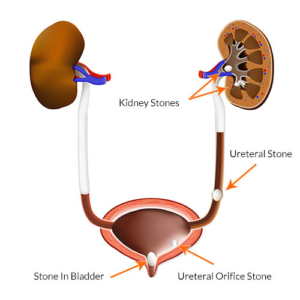Uretero-Renoscopic Stone Extraction with Laser (URSE)
A ureteric or renal calculus is removed with technique and may require a laser. A rigid/ flexible ureteroscope can be used.

Stones in the kidney, urinary bladder and ureter. medical illustration with a cross section of the kidney and bladder. anatomy of the urinary system. Human kidney.
Why is it done?
- Removal of renal or ureteric stones.
- Ureteric stones can vary from 5mm to over 1 cm in size.
- You may present with excruciating pain on the affected side. (This pain may be worse than childbirth).
- Renal stones usually larger than 1cm obstructing the renal pelvis.
- Or renal stones not causing any symptoms.
- Any fevers or a single kidney is deemed an emergency!
Two Treatment Options
- Ureteric Calculi.
- Managed with rigid ureteroscopy.
- Prior stenting with a ureteric stent,
- 7-10 days after stenting the stent is removed, and the stone is addressed with laser
- Renal Calculi.
- Prior stenting for 7-10 days.
- After stent removal the kidney is accessed with a flexible uretero-renoscope and the stone is fragmented with laser
How is it done? /Picture35.png)
-
- Patients will receive a general anesthesia.
- Prophylactic antibiotics is given.
- The correct kidney is identified and marked while you are awake.
- You would have had a cystoscopy with retrograde pyelogram 10 days prior with placement of ureteric stent to prepare your ureter.
- A cystoscopy will be done first to remove the stent, and 2 guidewires will be placed to enable access up the ureter.
- Depending on the position of the stone, either a rigid or flexible uretero-renoscope will be used.
- If a stone is in the kidney a flexible uretero-renoscope will be used with access obtained with an access sheath to protect the ureter from damage.
- Laser will be used to fragment the stone.
- All fragments will be attempted to be cleared. Small 1-2 mm fragments may be left as “Clinically Insignificant Fragments (CISF)” and will pass spontaneously.
- A Ureteric catheter with an indwelling catheter is left post-operatively overnight.
- Catheters will be removed the next morning depending on the presence of blood in the urine.
What next?
- You will spend at least one night in hospital.
- You will have a catheter for that time.
- On removal of your catheter, you may experience sharp colicky pain, exactly the same as your presenting renal colic. This is due to your ureter contracting back to its usual size. (The stent has dilated this to 5X its usual size).
- You will be discharged as soon as your pain has stabilized and you can function independently.
- Allow for a few days for stabilization of symptoms.
- A ward prescription will be issued on your discharge, for your own collection at any pharmacy.
- A follow-up appointment will be scheduled for 6 weeks. Stone analysis results will then be discussed in order to formulate a plan to proven recurrences
- DON’T SUFFER IN SILENCE, OR YOU WILL SUFFER ALONE!
Types of Stones:
- Calcium Oxalate.
- Uric Acid.
- Calcium Phosphate.
- Struvite (Infection stones).
- Cystine.
Download Information Sheet

Leave a Reply
Want to join the discussion?Feel free to contribute!